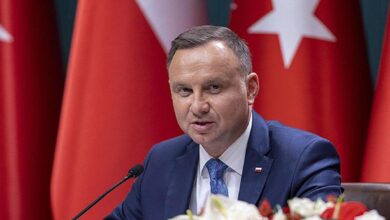
What is the Suwalki corridor / It is a strip of land located between Lithuania and Poland and with rising tensions between Moscow and the West, some commentators have described it as “a very dangerous place for Europe”.
It is the Suwalki corridor, an extension of about 70 km in length that connects Belarus, Moscow’s main ally, with Kaliningrad, the Russian territory embedded in Europe.
The corridor was recently a focus of tension after the sanctions that the European Union (EU) imposed in response to the invasion of Ukraine, Russia was prohibited from transporting some of its products to Kaliningrad through it.
Now some analysts are warning that the area could become one of Russian President Vladimir Putin’s first targets if he decides to escalate the war in Ukraine into open confrontation with NATO.
“The Russian and Belarusian armed forces have been training together extensively in the past to be able to take this area and keep NATO forces away,” Stephen Hall, professor of Politics, International Relations and Russia, tells BBC Mundo. from the University of Bath, England.
“Certainly this is (a) dangerous scenario. Because it would cut off NATO’s access to the Baltic states and therefore allow Russia to join those states as well,” the expert adds.
“Achilles heel” / What is the Suwalki corridor
It is because of the relative ease with which Russia could seize the Suwalki corridor that it has long been regarded as NATO’s “Achilles’ heel.”
The territory, a nearly uninhabited area consisting mainly of swamps, two highways and a single railway track, represents the shortest distance between Kaliningrad and Belarus.
Following the collapse of the Soviet Union, the Russian Federation held Kaliningrad.
But the heavily militarized enclave was now on the other side of Lithuania and Poland, cut off from Russia and its ally Belarus.
Despite repeated attempts by Russia during the 1990s to secure a zone that would allow a continued military presence between Belarus and Kaliningrad, all efforts failed.
It was only in 2003, when Poland and Lithuania were negotiating their accession to the European Union, that Russia achieved a more general treaty that allowed the transit of passengers and goods through the corridor between Lithuania and Poland.
Strategic importance
Initially, the vulnerability of the corridor, named after the Polish city of Suwalki, went almost unnoticed.
But when the Baltic states of Lithuania, Estonia and Latvia joined NATO, the corridor took on enormous strategic importance.
Its location meant that Kaliningrad was surrounded by NATO states; but also, the corridor created a bottleneck for the military alliance, in effect establishing a weak point – an “Achilles’ heel” – for the organization.
“The corridor between Kaliningrad and Belarus is definitely a bottleneck, not only in strictly military terms, but also in logistical terms for NATO support to the Estonian, Latvian and Lithuanian forces,” Professor Kenton tells BBC Mundo. White, professor of strategic studies at the University of Reading, England, and co-director of the Ways of War Center at the University of Reading.
“Because if the Russians were to close that corridor militarily, and also impose a naval blockade on the Baltic, then NATO would be left in a very difficult situation as to how to supply even basic materials, food and fuel to the three Baltic states,” he added. expert.
The strategic position of the corridor, and the possibility of Russia seizing the territory, became even more important after Moscow annexed Crimea in 2014.
And many analysts saw that possibility even closer after Russia’s invasion of Ukraine in February this year.
Heavily militarized area
To be sure, for NATO, the area became important enough to position a US-led Enhanced Forward Presence (eFP) task force in Orzysz, Poland, near the Lithuanian border.
And since 2014 the military situation in the region has steadily escalated and the concentration of firepower has increased dramatically on both sides.
Tension in the area reached new levels in June when Lithuania banned the transit of steel and other ferrous metals through the Suwalki corridor due to sanctions imposed by the EU over the invasion of Ukraine.
In July, Lithuania withdrew the ban, but the original decision had provoked the ire of Moscow, which threatened to respond to the blockade and condemned the sanctions as illegal and unacceptable.
The head of the Russian security council, Nikolai Patrushev, threatened a “serious negative impact on the population of Lithuania”.
Another Russian annexation?
The Lithuanian blockade revived fears of a Russian annexation of the Suwalki corridor.
But not all experts believe that Moscow is willing to take such action when its forces are engaged in the invasion of Ukraine.
“I think it’s highly unlikely,” says Professor Stephen Hall. “Russia is installing much of its (military) capability in Ukraine, where it hasn’t done a particularly spectacular job.”
“It’s a war of attrition. It’s making some progress, but it’s going to get harder and harder to get reinforcements and make the difficult decision to reinforce Donbas to try to push out the Ukrainians or leave (other cities) open to counter-attack.” , Explain.
But furthermore, if Russian forces were to seize the corridor, which is NATO territory, that would result in an immediate confrontation between Russia and the alliance members.
Because any Russian action on the territory of Poland or Lithuania would lead to the application of Article 5 which states that an attack on a NATO member represents an attack on all the nations of the organization.
As Stepehn Hall points out, Russia “cannot afford to escalate a war that would bring NATO close to its full capacity.”
But would Washington, London and other members of the alliance be willing to intervene in a confrontation with Russia over virtually unpopulated territory?
The co-director of the Center on Aspects of Warfare at the University of Reading, Kenton White, does not believe that all NATO members are willing to do so.
“It would be very difficult for the Russians, even with the support of Belarus, (to take the corridor) because NATO has been sending more troops to the area”
“But if that situation were to come, there would be some NATO countries that might not be prepared to confront Russian forces directly, regardless of Article 5.”
“I think of countries like Germany, Belgium, maybe Denmark, who might not necessarily be willing to get involved in a situation like that.”
It must be remembered that in Kaliningrad, Russia has established a formidable military presence that includes its Baltic fleet, tens of thousands of soldiers and there have even been reports that it has deployed nuclear weapons in the enclave of nearly a million people.
As Kenton White points out, NATO’s Article 5 does not state that members must provide military force, and furthermore, “there is a strong feeling among some NATO members that a military confrontation is something they want to avoid at all costs.”
The reinforcement of Finland and Sweden
The truth is that, as the professor at the University of Reading states, the corridor is currently “a very dangerous place for Europeans and certainly a threat to NATO.”
And with the expected NATO accession of Sweden and Finland it has further increased tensions between Russia and the West.
The inclusion of the two Scandinavian countries will turn the Baltic Sea into what some analysts call “a NATO lake”.
And this could perhaps give Moscow an even greater incentive to build a “bridge” between Belarus and Kaliningrad.
But experts say that with Sweden and Finland being members of NATO, the Suwalki corridor will no longer be a weak point in the military alliance.
“(The runner) will no longer be an Achilles’ heel,” says Kenton White of the University of Reading.
“With Finland there will be a direct route to the Baltic states, which is not available now. So the corridor will no longer be a big threat to the functioning of NATO.”
“We certainly have to worry about Putin’s long-term intentions towards NATO and the corridor could be a flash point.”
“But the accession of Finland and Sweden will alleviate fears about the area and tip the balance of the region in favor of NATO,” says the expert.
NATO signs accession protocols for Finland and Sweden
Unknown substance discovered in the Baltic Sea



